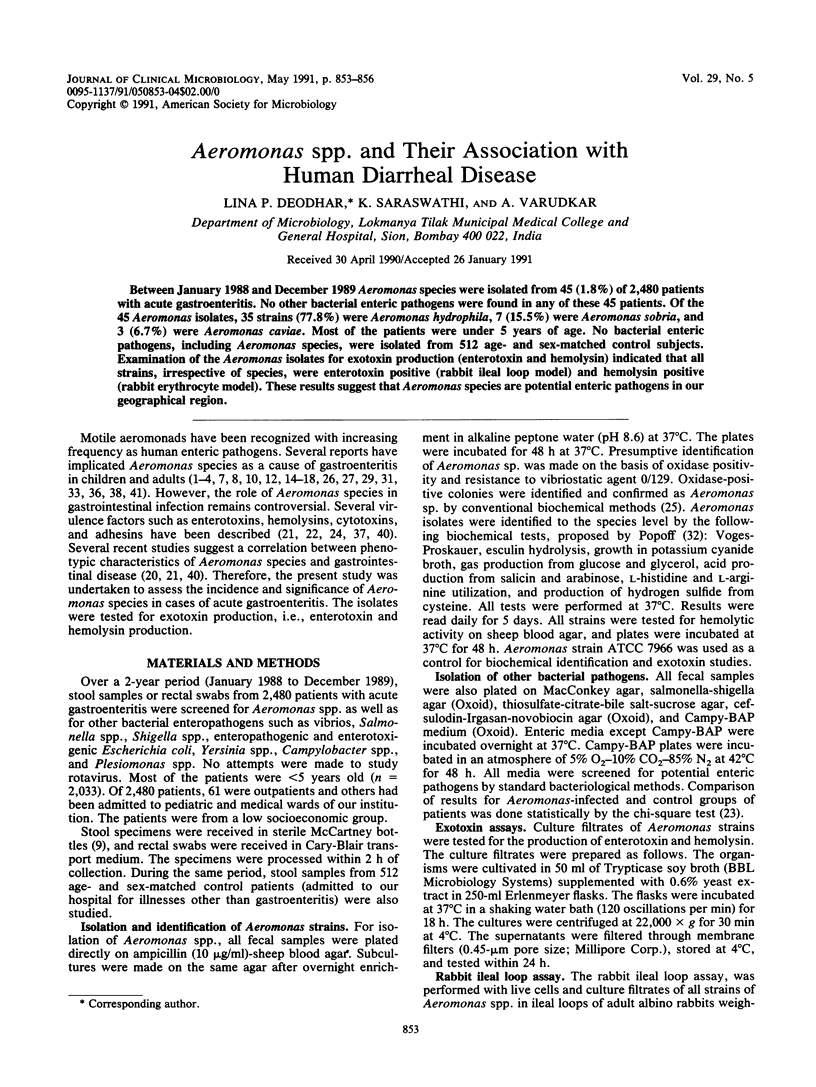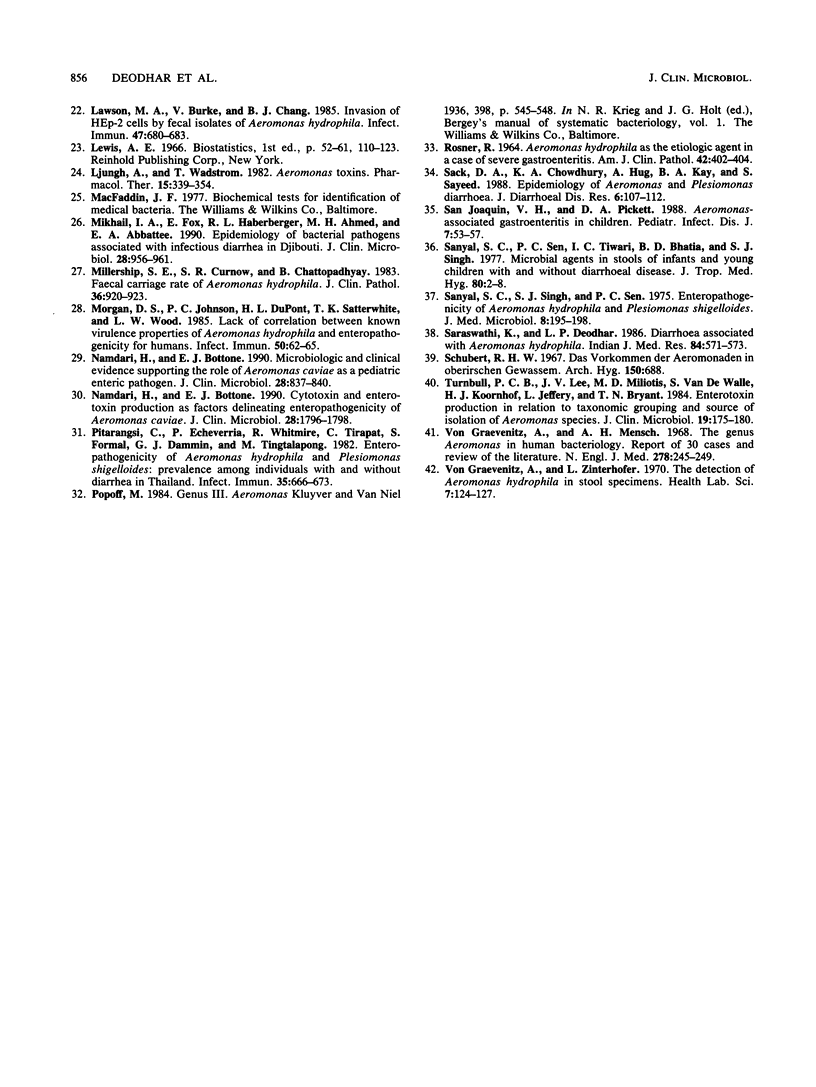Abstract
Between January 1988 and December 1989 Aeromonas species were isolated from 45 (1.8%) of 2,480 patients with acute gastroenteritis. No other bacterial enteric pathogens were found in any of these 45 patients. Of the 45 Aeromonas isolates, 35 strains (77.8%) were Aeromonas hydrophila, 7 (15.5%) were Aeromonas sobria, and 3 (6.7%) were Aeromonas caviae. Most of the patients were under 5 years of age. No bacterial enteric pathogens, including Aeromonas species, were isolated from 512 age- and sex-matched control subjects. Examination of the Aeromonas isolates for exotoxin production (enterotoxin and hemolysin) indicated that all strains, irrespective of species, were enterotoxin positive (rabbit ileal loop model) and hemolysin positive (rabbit erythrocyte model). These results suggest that Aeromonas species are potential enteric pathogens in our geographical region.
Full text
PDF



Selected References
These references are in PubMed. This may not be the complete list of references from this article.
- Agger W. A., McCormick J. D., Gurwith M. J. Clinical and microbiological features of Aeromonas hydrophila-associated diarrhea. J Clin Microbiol. 1985 Jun;21(6):909–913. doi: 10.1128/jcm.21.6.909-913.1985. [DOI] [PMC free article] [PubMed] [Google Scholar]
- Altwegg M., Jöhl M. Isolation frequency of Aeromonas species in relation to patient age. Eur J Clin Microbiol. 1987 Feb;6(1):55–56. doi: 10.1007/BF02097193. [DOI] [PubMed] [Google Scholar]
- Bhat P., Shanthakumari S., Rajan D. The characterization and significance of Plesiomonas shigelloides and Aeromonas hydrophila isolated from an epidemic of diarrhoea. Indian J Med Res. 1974 Jul;62(7):1051–1060. [PubMed] [Google Scholar]
- Burke V., Gracey M., Robinson J., Peck D., Beaman J., Bundell C. The microbiology of childhood gastroenteritis: Aeromonas species and other infective agents. J Infect Dis. 1983 Jul;148(1):68–74. doi: 10.1093/infdis/148.1.68. [DOI] [PubMed] [Google Scholar]
- Catsaras M., Buttiaux R. Les Aeromonas dans les matières fécales humaines. Ann Inst Pasteur Lille. 1965;16:85–88. [PubMed] [Google Scholar]
- Challapalli M., Tess B. R., Cunningham D. G., Chopra A. K., Houston C. W. Aeromonas-associated diarrhea in children. Pediatr Infect Dis J. 1988 Oct;7(10):693–698. doi: 10.1097/00006454-198810000-00005. [DOI] [PubMed] [Google Scholar]
- Champsaur H., Adremont A., Mathieu D., Rottman E., Auzepy P. Cholera-like illness due to Aeromonas sobria. J Infect Dis. 1982 Feb;145(2):248–254. doi: 10.1093/infdis/145.2.248. [DOI] [PubMed] [Google Scholar]
- Chatterjee B. D., Neogy K. N. Studies on Aeromonas and Plesiomonas species isolated from cases of choleraic diarrhoea. Indian J Med Res. 1972 Apr;60(4):520–524. [PubMed] [Google Scholar]
- Dhalla S., Flynn J. T. Aeromonas hydrophila-induced fulminant diarrhea. N Y State J Med. 1980 Dec;80(13):1965–1966. [PubMed] [Google Scholar]
- Echeverria P., Blacklow N. R., Sanford L. B., Cukor G. G. Travelers' diarrhea among American Peace Corps volunteers in rural Thailand. J Infect Dis. 1981 Jun;143(6):767–771. doi: 10.1093/infdis/143.6.767. [DOI] [PubMed] [Google Scholar]
- Figura N., Marri L., Verdiani S., Ceccherini C., Barberi A. Prevalence, species differentiation, and toxigenicity of Aeromonas strains in cases of childhood gastroenteritis and in controls. J Clin Microbiol. 1986 Mar;23(3):595–599. doi: 10.1128/jcm.23.3.595-599.1986. [DOI] [PMC free article] [PubMed] [Google Scholar]
- George W. L., Nakata M. M., Thompson J., White M. L. Aeromonas-related diarrhea in adults. Arch Intern Med. 1985 Dec;145(12):2207–2211. [PubMed] [Google Scholar]
- Goodwin C. S., Harper W. E., Stewart J. K., Gracey M., Burke V., Robinson J. Enterotoxigenic Aeromonas hydrophila and diarrhoea in adults. Med J Aust. 1983 Jan 8;1(1):25–26. doi: 10.5694/j.1326-5377.1983.tb136018.x. [DOI] [PubMed] [Google Scholar]
- Gracey M., Burke V., Robinson J. Aeromonas-associated gastroenteritis. Lancet. 1982 Dec 11;2(8311):1304–1306. doi: 10.1016/s0140-6736(82)91510-0. [DOI] [PubMed] [Google Scholar]
- Holmberg S. D., Schell W. L., Fanning G. R., Wachsmuth I. K., Hickman-Brenner F. W., Blake P. A., Brenner D. J., Farmer J. J., 3rd Aeromonas intestinal infections in the United States. Ann Intern Med. 1986 Nov;105(5):683–689. doi: 10.7326/0003-4819-105-5-683. [DOI] [PubMed] [Google Scholar]
- Janda J. M., Reitano M., Bottone E. J. Biotyping of Aeromonas isolates as a correlate to delineating a species-associated disease spectrum. J Clin Microbiol. 1984 Jan;19(1):44–47. doi: 10.1128/jcm.19.1.44-47.1984. [DOI] [PMC free article] [PubMed] [Google Scholar]
- Kirov S. M., Rees B., Wellock R. C., Goldsmid J. M., Van Galen A. D. Virulence characteristics of Aeromonas spp. in relation to source and biotype. J Clin Microbiol. 1986 Nov;24(5):827–834. doi: 10.1128/jcm.24.5.827-834.1986. [DOI] [PMC free article] [PubMed] [Google Scholar]
- Kuijper E. J., Bol P., Peeters M. F., Steigerwalt A. G., Zanen H. C., Brenner D. J. Clinical and epidemiologic aspects of members of Aeromonas DNA hybridization groups isolated from human feces. J Clin Microbiol. 1989 Jul;27(7):1531–1537. doi: 10.1128/jcm.27.7.1531-1537.1989. [DOI] [PMC free article] [PubMed] [Google Scholar]
- Lawson M. A., Burke V., Chang B. J. Invasion of HEp-2 cells by fecal isolates of Aeromonas hydrophila. Infect Immun. 1985 Mar;47(3):680–683. doi: 10.1128/iai.47.3.680-683.1985. [DOI] [PMC free article] [PubMed] [Google Scholar]
- Ljungh A., Wadström T. Aeromonas toxins. Pharmacol Ther. 1981;15(3):339–354. doi: 10.1016/0163-7258(81)90049-8. [DOI] [PubMed] [Google Scholar]
- Mikhail I. A., Fox E., Haberberger R. L., Jr, Ahmed M. H., Abbatte E. A. Epidemiology of bacterial pathogens associated with infectious diarrhea in Djibouti. J Clin Microbiol. 1990 May;28(5):956–961. doi: 10.1128/jcm.28.5.956-961.1990. [DOI] [PMC free article] [PubMed] [Google Scholar]
- Millership S. E., Curnow S. R., Chattopadhyay B. Faecal carriage rate of Aeromonas hydrophila. J Clin Pathol. 1983 Aug;36(8):920–923. doi: 10.1136/jcp.36.8.920. [DOI] [PMC free article] [PubMed] [Google Scholar]
- Morgan D. R., Johnson P. C., DuPont H. L., Satterwhite T. K., Wood L. V. Lack of correlation between known virulence properties of Aeromonas hydrophila and enteropathogenicity for humans. Infect Immun. 1985 Oct;50(1):62–65. doi: 10.1128/iai.50.1.62-65.1985. [DOI] [PMC free article] [PubMed] [Google Scholar]
- Namdari H., Bottone E. J. Cytotoxin and enterotoxin production as factors delineating enteropathogenicity of Aeromonas caviae. J Clin Microbiol. 1990 Aug;28(8):1796–1798. doi: 10.1128/jcm.28.8.1796-1798.1990. [DOI] [PMC free article] [PubMed] [Google Scholar]
- Namdari H., Bottone E. J. Microbiologic and clinical evidence supporting the role of Aeromonas caviae as a pediatric enteric pathogen. J Clin Microbiol. 1990 May;28(5):837–840. doi: 10.1128/jcm.28.5.837-840.1990. [DOI] [PMC free article] [PubMed] [Google Scholar]
- Pitarangsi C., Echeverria P., Whitmire R., Tirapat C., Formal S., Dammin G. J., Tingtalapong M. Enteropathogenicity of Aeromonas hydrophila and Plesiomonas shigelloides: prevalence among individuals with and without diarrhea in Thailand. Infect Immun. 1982 Feb;35(2):666–673. doi: 10.1128/iai.35.2.666-673.1982. [DOI] [PMC free article] [PubMed] [Google Scholar]
- ROSNER R. AEROMONAS HYDROPHILA AS THE ETIOLOGIC AGENT IN A CASE OF SEVERE GASTROENTERITIS. Am J Clin Pathol. 1964 Oct;42:402–404. doi: 10.1093/ajcp/42.4.402. [DOI] [PubMed] [Google Scholar]
- Sack D. A., Chowdhury K. A., Huq A., Kay B. A., Sayeed S. Epidemiology of Aeromonas and Plesiomonas diarrhoea. J Diarrhoeal Dis Res. 1988 Jun;6(2):107–112. [PubMed] [Google Scholar]
- San Joaquin V. H., Pickett D. A. Aeromonas-associated gastroenteritis in children. Pediatr Infect Dis J. 1988 Jan;7(1):53–57. doi: 10.1097/00006454-198801000-00013. [DOI] [PubMed] [Google Scholar]
- Sanyal S. C., Sen P. C., Tiwari I. C., Bhatia B. D., Singh S. J. Microbial agents in stools of infants and young children with and without acute diarrhoeal disease. J Trop Med Hyg. 1977 Jan;80(1):2–8. [PubMed] [Google Scholar]
- Sanyal S. C., Singh S. J., Sen P. C. Enteropathogenicity of Aeromonas hydrophila and Plesiomonas shigelloides. J Med Microbiol. 1975 Feb;8(1):195–198. doi: 10.1099/00222615-8-1-195. [DOI] [PubMed] [Google Scholar]
- Saraswathi K., Deodhar L. P. Diarrhoea associated with Aeromonas hydrophila. Indian J Med Res. 1986 Dec;84:571–573. [PubMed] [Google Scholar]
- Schubert R. H. Das Vorkommen der Aeromonaden in oberirdischen Gewässern. Arch Hyg Bakteriol. 1967 Mar;150(7):688–708. [PubMed] [Google Scholar]
- Turnbull P. C., Lee J. V., Miliotis M. D., Van de Walle S., Koornhof H. J., Jeffery L., Bryant T. N. Enterotoxin production in relation to taxonomic grouping and source of isolation of Aeromonas species. J Clin Microbiol. 1984 Feb;19(2):175–180. doi: 10.1128/jcm.19.2.175-180.1984. [DOI] [PMC free article] [PubMed] [Google Scholar]
- Von Graevenitz A., Mensch A. H. The genus aeromonas in human bacteriology report of 30 cases and review of the literature. N Engl J Med. 1968 Feb 1;278(5):245–249. doi: 10.1056/NEJM196802012780504. [DOI] [PubMed] [Google Scholar]
- von Graevenitz A., Zinterhofer L. The detection of Aeromonas hydrophila in stool specimens. Health Lab Sci. 1970 Jul;7(3):124–127. [PubMed] [Google Scholar]


